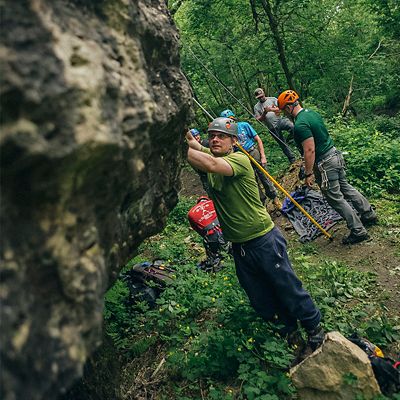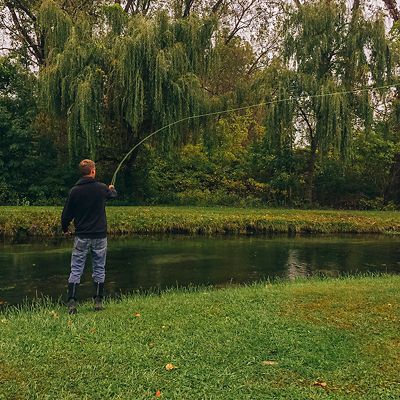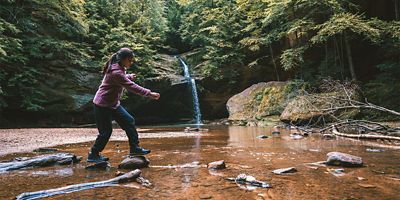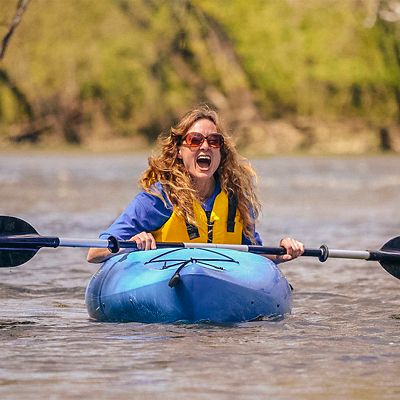Central Ohio is an underrated fishing destination. That’s according to Bob Johnson, who’s been fishing the reservoirs, lakes, and streams of this area for six decades.
“We’re surrounded by water,” Johnson explains. “And wherever you find water around here, you’ll find fish.”
Today, Johnson passes on that wealth of knowledge to anglers of all stripes in his role as a concierge at the Public Lands store in Polaris. He spends his workdays chatting with other anglers and comparing notes on where to fish, what equipment to use, and what bait works best. Through those exchanges, he ensures that the community has a friendly resource to tap into—and that his own knowledge of local fishing holes is always kept sharp.
Here are a few of Johnson’s other top recommendations for the best fishing spots in Central Ohio.
Big Walnut Creek
Big Walnut Creek, a tributary of the Scioto River just south of Columbus, is one of Johnson’s favorite honey holes. The creek is wide, serene, and chock full of smallmouth bass. “You can gain access from the banks, especially around the bridges,” Johnson explains. This is a good bet for bass, which tend to love the shallows. You can cast from the banks, or paddle out into the creek.
Antrim Park
Located in Clintonville, near the Olentangy River, Antrim Park is a 120-acre quarried lake. The current state record for saugeye (14.04 pounds) was caught here in 2004. However, while you can find saugeye in Antrim, they’re not stocked. (It’s thought that this record-breaker swam over from the Olentangy during a high-water period.) The good news? The Ohio Department of Natural Resources does stock rainbow trout here every year, from March to May.
No boats (motorized or paddle-powered) are allowed in Antrim, but there’s a large dock and plenty of spots along the banks from which to cast.
Olentangy River
The removal of the dams located along the Ohio State University campus and downtown Columbus returned the river to its more natural state and improved the fishing. Locals can be found casting down from bridges and along the banks (where accessible). The area from Fifth Avenue north to the Dodridge Street low-head dam (just north of OSU) is a particularly good spot to cast.
There are smallmouth bass, saugeye, catfish, and carp. And you don’t have to work too hard to drop a line for them, either: Many anglers fish from atop the bridges that span the Olentangy, and there are several spots along the multi-use trail that cut through the trees and make it easy to get to the water’s edge.
Scioto River
The tree-lined Scioto River also boasts a population of smallmouth bass, saugeye, catfish, and carp. A few of the best spots are north of Columbus, in Dublin, from Scioto Park to Griggs Reservoir. The water here is shallow, and wading is an option. You’ll find another productive fishing spot just south of downtown Columbus, at the launch in the Scioto Audubon Metro Park.
Big Darby Creek
This is one of the more scenic and peaceful fishing spots in the area. There’s a canoe-access spot at the Alkire Road parking lot of Battelle Darby Creek Metro Park. From here you can paddle off, or wade along the shallow waters and fish for smallmouth bass, largemouth bass, rock bass, and channel catfish. The slow-moving, deep pools are the best places to find these fish.
Alum Creek State Park Lake
The massive, forest- and cliff-lined Alum Creek is a popular fishing destination, and for good reason. There are saugeyes here as big as 18 inches, crappies up to a foot, and plenty of channel catfish, bluegills, muskies, and smallmouth bass and white bass.
Muskies can be found in the lower basin of the lake, between the Cheshire Road causeway and the dam. The muskies here can reach 30 or more inches, so it’s best to come prepared with a rod and reel that can withstand some serious force.
Hoover Reservoir
This is another popular spot, due in part to the size of the reservoir (2,800 acres), the abundance of fish, and the 10-horsepower outboard motor limit, which leads to a quieter and more peaceful environment for anglers.
There are also plenty of spots along the 45 miles of shoreline from which to cast for fish. And the types of quarry abound: Here, you’ll find largemouth bass, smallmouth bass, crappie, saugeye, catfish, white bass, and bluegill.









